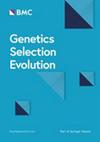QTL数量与训练集候选性状特异性基因组关系的负相关研究。
IF 3.1
1区 农林科学
Q1 AGRICULTURE, DAIRY & ANIMAL SCIENCE
引用次数: 0
摘要
基因组预测的准确性取决于性状的遗传力、训练集的大小、候选基因与训练集的关系以及$$\text {Min}(N_{\text {QTL}},M_e)$$,其中$$N_{\text {QTL}}$$是QTL的数量,$$M_e$$是独立分离的染色体片段的数量。由于LD的存在,独立分离的QTL(有效QTL)数量$$Q_e$$可能低于$$\text {Min}(N_{\text {QTL}},M_e)$$。在本文中,我们表明$$Q_e$$与训练集候选人的性状特异性基因组关系呈负相关。这就解释了$$Q_e$$与预测精度之间的负相关关系。为了量化候选对象与训练集所有成员的基因组关系,我们考虑了先前用于此目的的$$k^2$$统计量。它量化了候选人的标记协变量向量可以如何很好地表示为训练集的标记协变量矩阵的行的线性组合。在本文中,我们使用贝叶斯回归使这一统计特征特异性,并认为候选对象与训练集的性状特异性基因组关系与$$Q_e$$呈负相关。通过仿真验证了特定性状的$$k^2$$统计量对$$Q_e$$的依赖性,而与$$N_{\text {QTL}}$$相关。性状特异性$$k^2$$统计量的后验分布表明,候选基因与训练集之间的性状特异性基因组关系与$$Q_e$$和$$N_{\text {QTL}}$$呈负相关。此外,我们表明候选基因与训练集之间的性状特异性基因组关系与训练集的大小直接相关。本文章由计算机程序翻译,如有差异,请以英文原文为准。
On the inverse association between the number of QTL and the trait-specific genomic relationship of a candidate to the training set.
Accuracy of genomic prediction depends on the heritability of the trait, the size of the training set, the relationship of the candidates to the training set, and the $$\text {Min}(N_{\text {QTL}},M_e)$$ , where $$N_{\text {QTL}}$$ is the number of QTL and $$M_e$$ is the number of independently segregating chromosomal segments. Due to LD, the number $$Q_e$$ of independently segregating QTL (effective QTL) can be lower than $$\text {Min}(N_{\text {QTL}},M_e)$$ . In this paper, we show that $$Q_e$$ is inversely associated with the trait-specific genomic relationship of a candidate to the training set. This provides an explanation for the inverse association between $$Q_e$$ and the accuracy of prediction. To quantify the genomic relationship of a candidate to all members of the training set, we considered the $$k^2$$ statistic that has been previously used for this purpose. It quantifies how well the marker covariate vector of a candidate can be represented as a linear combination of the rows of the marker covariate matrix of the training set. In this paper, we used Bayesian regression to make this statistic trait specific and argue that the trait-specific genomic relationship of a candidate to the training set is inversely associated with $$Q_e$$ . Simulation was used to demonstrate the dependence of the trait-specific $$k^2$$ statistic on $$Q_e$$ , which is related to $$N_{\text {QTL}}$$ . The posterior distributions of the trait-specific $$k^2$$ statistic showed that the trait-specific genomic relationship between a candidate and the training set is inversely associated to $$Q_e$$ and $$N_{\text {QTL}}$$ . Further, we show that trait-specific genomic relationship between a candidate and the training set is directly related to the size of the training set.
求助全文
通过发布文献求助,成功后即可免费获取论文全文。
去求助
来源期刊

Genetics Selection Evolution
生物-奶制品与动物科学
CiteScore
6.50
自引率
9.80%
发文量
74
审稿时长
1 months
期刊介绍:
Genetics Selection Evolution invites basic, applied and methodological content that will aid the current understanding and the utilization of genetic variability in domestic animal species. Although the focus is on domestic animal species, research on other species is invited if it contributes to the understanding of the use of genetic variability in domestic animals. Genetics Selection Evolution publishes results from all levels of study, from the gene to the quantitative trait, from the individual to the population, the breed or the species. Contributions concerning both the biological approach, from molecular genetics to quantitative genetics, as well as the mathematical approach, from population genetics to statistics, are welcome. Specific areas of interest include but are not limited to: gene and QTL identification, mapping and characterization, analysis of new phenotypes, high-throughput SNP data analysis, functional genomics, cytogenetics, genetic diversity of populations and breeds, genetic evaluation, applied and experimental selection, genomic selection, selection efficiency, and statistical methodology for the genetic analysis of phenotypes with quantitative and mixed inheritance.
 求助内容:
求助内容: 应助结果提醒方式:
应助结果提醒方式:


